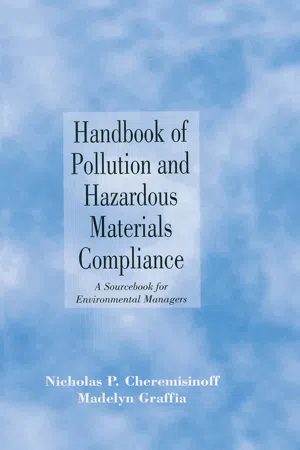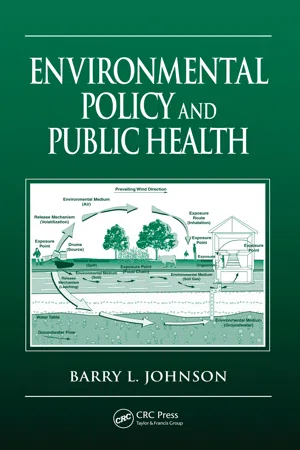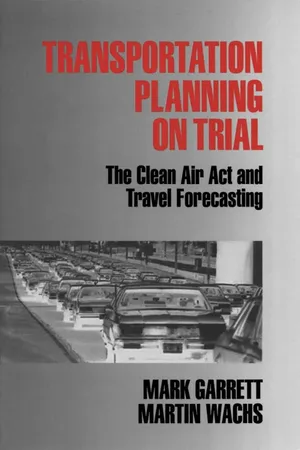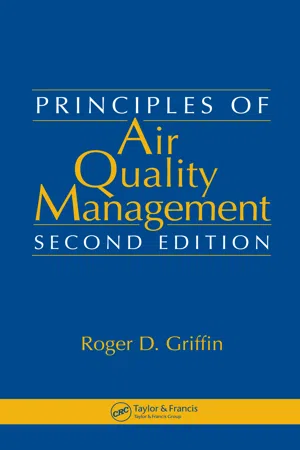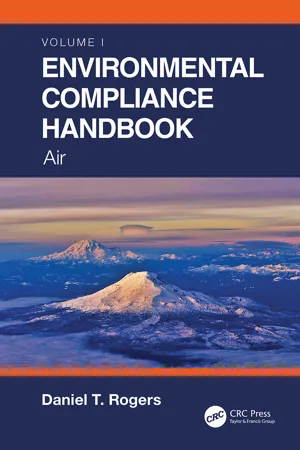Law
Clean Air Act Enforcement
The Clean Air Act Enforcement refers to the regulatory actions taken to ensure compliance with the Clean Air Act, a federal law aimed at controlling air pollution. Enforcement activities include monitoring, inspections, and penalties for violations. The goal is to protect public health and the environment by holding individuals and organizations accountable for maintaining air quality standards.
Written by Perlego with AI-assistance
Related key terms
1 of 5
10 Key excerpts on "Clean Air Act Enforcement"
- eBook - PDF
Handbook of Pollution and Hazardous Materials Compliance
A Sourcebook for Environmental Managers
- Nicholas P. Cheremisinoff, Madelyn Graffia(Authors)
- 1996(Publication Date)
- CRC Press(Publisher)
2. Accelerated research, training, and technical assistance. 3. Federal enforcement authority to abate interstate air pollution problems. 4. Federal research responsibility for automobile and sulfur oxides pollution. 5. Air quality criteria development for the protection of public health and welfare. The Clean Air Act 73 In this first Clean Air Act, there was no provision for hazardous materials emission and standards, and primary responsibility for pollution control still remained with state and local governments. Even though considerable progress was made with the enactment of the Clean Air Act of 1963, air pollution problems continued to escalate and enforcement levels continued to be ineffectual. In 1967, Congress passed the Comprehensive Air Quality Act, which further strengthened the country's air pollution control effort. Many of the pollution control concepts developed in 1967 still offer the basic framework for our current control efforts. Perhaps the most significant of these concepts was the development and implementation of air quality standards. The act required the Secretary of Health, Education, and Welfare to designate Air Quality Control Regions and issue air quality criteria and control technique information. Moreover, individual states were required to delineate state air quality standards and plan for their implementation on a fixed time schedule. The federal government was given even more authority, but still, it didn't compare to the primary responsibility of enforcement that lied in the states' hands. The basic regulatory structure of today's Clean Air Act was formed when Congress passed the CAA of 1970, which federalized air pollution control due to the public's dissatisfaction with the progress of the Air Quality Act. It made health protection the basis for much of that regulation, clarified the emission standards for automotive and other industries and created a pervasive regulatory system. - eBook - PDF
- Barry L. Johnson(Author)
- 2006(Publication Date)
- CRC Press(Publisher)
Consider the problem posed by a regional airshed (i.e., a geographic area such as a city and its outlying metropolitan areas). As-suming that quality standards have been established for individual air pollutants (e.g., particulate matter), how can emission standards be established to control sources of 153 General Environmental Statutes pollution within the airshed? Setting emission standards to apply to an airshed requires authorities, normally state agencies acting under federal law (e.g., the Clean Air Act), to identify sources of air pollution, derive emission standards for polluting sources, and work through a regulatory apparatus to implement the emission standards. The process is complicated by uncertainties in characterizing sources of pollution and computer mod-eling of airshed pollutants. Moreover, producers of pollution will resist those emission standards they consider as too costly. Protracted litigation is often the result. 4.3 ENFORCEMENT AND PENALTIES Federal statutes that require federal agencies to develop regulations and standards and control of environmental hazards in general also contain enforcement authorities. The enforcement authorities are normally accompanied by penalties for failure to comply with specific statutory requirements. For example, under the Clean Air Act, §113, EPA is authorized, in ascending order of severity, to: (1) issue an administrative penalty order, (2) issue an order of compliance, (3) bring a civil action, or (4) request the U.S. attorney general to commence a criminal action. Examples of EPA enforcement ac-tions and penalties are found in chapters 5 through 8. The examples are given for the purpose of showing the seriousness of federal enforcement authorities and illustrate the civil (monetary penalties) and criminal (felony actions) consequences of failure to meet statutory directives. - eBook - PDF
- Lyle Albright(Author)
- 2008(Publication Date)
- CRC Press(Publisher)
However, these costs serve as prudently invested dollars when weighed against the ramifications of environmental policy inaction, whether as regulatory fines or market share loss. Adherence to the various Code of Federal Regulations (CFR) that apply to a large number of U.S. industries can prevent public embarrassment and help maintain customer loyalty. This chapter will focus on statutes and mandates of the U.S. Environmental Protection Agency (EPA) enforceable by various federal regulations, as well as discuss the state of engineering and management tools available for managing corporate compliance, and provide numerous online resources suitable for in-depth investigation of each topic. As a quick reference, government agencies that have important bearing on the environment can be contacted via the following sites: • The U.S. Environmental Protection Agency (EPA) www.EPA.gov • The U.S. Nuclear Regulatory Commission (NRC) www.nrc.gov • The U.S. Department of Energy (DOE) www.doe.gov • Occupational Safety & Health Administration (OSHA) www.osha.gov • U.S. Department of Health and Human Services (HHS) www.hhs.gov 18.2 THE CLEAN AIR ACT (http://epa.gov/air/caa/) 18.2.1 B ACKGROUND AND P OLLUTANT T YPES The Clean Air Act (CAA) establishes monitoring and reporting mechanisms, air pollution inven-tories and reporting thresholds, and economic incentives for controlling and/or reducing pollutant Environmental Engineering: A Review of Issues, Regulations, and Resources 1487 emissions from manufacturing sectors of all types. The CAA monitors the National Ambient Air Quality Standards (NAAQS) via State Implementation Plans (SIP) to ensure consistent air quality for all U.S. residents. Each SIP adheres to the requirements of the CAA by assigning applicable air pollutants to one of two categories: • Criteria Pollutants: Pollutants for which a primary (personal safety threshold) or second-ary (environmental threshold) limit exists. - eBook - PDF
- John T. Quigley, Frank L. Cross Jr., Howard D. Hesketh(Authors)
- 2014(Publication Date)
- CRC Press(Publisher)
I CHAPTER 1 The Clean Air Act FRANK W. SHERMAN HOWARD E. HESKETH 1.1 BACKGROUND A ir pollution regulations may be set by federal, state or local reg ulatory bodies. Regulations set by any of these bodies must be at least as strict as those established by the next higher level of government. Fed eral regulations set by Congress are published daily in the Federal Register. Those are then, in elfect, laws. These regulations are codified annually into the Code of Federal Regula tions, CFR. Title 40 of the CFR is “Protection of Environment.” This con tains all the EPA regulations and covers rule making and policies of the Administrator. Title 40 part numbers and subchapter topics are • 40 CFR 1-51 (Air Regs, Grants/Federal Assis.) • 40 CFR 52-99 (Air Programs) • 40 CFR 100-149 (Water Programs) • 40 CFR 150-189 (FIFRA-Pesticide Programs) • 40 CFR 190-259 (RCRA, Radiation, Ocean Dumping, Solid Wastes) • 40 CFR 260-299 (RCRA, Hazardous Wastes) • 40 CFR 300-399 (CERCLA/Superfund/SARA Title III) • 40 CFR 400-699 (Water Effluent Guidelines and Standards) • 40 CFR 700-END (TSCA) The Clean Air Act (CAA) of 1963 initiated most of the air pollution con trol activities in the U.S. This act is amended periodically by Congress. For example, it was significantly amended in 1965, 1966, 1967 (Federal Air Quality Act), 1968, 1970, 1977, 1987 (Amendments to Criteria Pollutant Values) and 1990. 1 2 THE CLEAN AIR ACT The Clean Air Act provisions for cleaning the air are based upon the es tablishment of Air Quality Standards for several pollutants. Since 1970, the EPA has established National Ambient Air Quality Standards (NAAQS) for five “criteria” pollutants: ozone, carbon monoxide, particulate matter, nitrogen oxides and sulfur dioxide. Lead and respirable particulate (i.e., PM 10—particulate matter with a mean diameter less than ten microns) were added later. - eBook - ePub
- Donald J. Rebovich, George E. Curtis(Authors)
- 2020(Publication Date)
- Routledge(Publisher)
The Clean Air Act (CAA) was enacted in 1963 for the stated purpose “to protect and enhance the quality of the Nation’s air resources” (42 U.S.C. §7401[b]). The Act authorizes the Environmental Protection Agency (EPA) to establish National Ambient Air Quality Standards (NAAQS) and directs the states to establish a State Implementation Plan (SIP) for the reduction of air pollution. The Act further directs the EPA to establish National Emission Standards for Hazardous Air Pollutants (NESHAP). Essentially, the EPA establishes the national air pollution control standards that states are responsible for enforcing at state and local levels through EPA-approved SIPs.Individuals and entities can violate the CAA in a number of ways: (1) by emitting “criteria pollutants” (carbon monoxide, sulfur oxides, nitrogen dioxide, particulate matter, ozone, and lead) in violation of standards set forth in state plans; (2) by emitting hazardous air pollutants in violation of NESHAP; (3) by emitting pollutants in violation of the New Source Performance Standards (NSPS), which apply to major sources of air pollution; (4) by emitting sulfur dioxide in excess of limiting standards; and (5) by emitting or producing an unauthorized ozone-affecting substance.The criminal violations of the CAA are set forth in 42 U.S.C. §7413(c). Essentially, the Act imposes criminal sanctions upon those who engage in the conduct set forth in the preceding paragraph; interfere with or fail to install EPA monitoring devices; fail to notify or file reports as required by the CAA; make false statements or certifications or who omit material information from any report, plan, or other documents; and those who fail to pay fees that are owed to the United States.Water
The Clean Water Act (CWA) was enacted in 1977 with the objective to “restore and maintain the chemical, physical, and biological integrity of the Nation’s waters” (33 U.S.C. §1251[a]). The Act is designed to accomplish this purpose by prohibiting the discharge of any pollutant into “navigable waters” of the United States without a permit issued under the National Pollutant Discharge Elimination System (NPDES) permit program. - eBook - PDF
Transportation Planning on Trial
The Clean Air Act and Travel Forecasting
- Mark Garrett, Martin Wachs(Authors)
- 1996(Publication Date)
- SAGE Publications, Inc(Publisher)
The Clean Air Act Congress passed the Clean Air Act in 1955. 9 It was mainly designed to foster cooperation between federal, state, and local government agencies in air pollution prevention and abatement efforts. Within less than two decades, however, national concern over the deteriorating air quality in many cities led to a substantial amendment called the Air Quality Act of 1967, 1 0 followed 3 years later by a major revision known as the Clean Air Amendments of 1970. Automobiles are a major source of air pollution and it was recognized that constructing new freeways, although initially reducing traffic conges-tion, also tended to generate additional demand for travel. Among other things, the 1970 amendments gave states broad authority to adopt transpor-tation control measures, commonly known as TCMs, to restrict automobile 10 TRANSPORTATION PLANNING ON TRIAL use and provide incentives for alternatives to single-occupant vehicle (SOV) trips, such as public mass transit. The amendment's congressional sponsors anticipated, perhaps naively, that the legislation would dramatically change the public's driving habits. Curbing traffic growth would prove more diffi-cult than expected, however, and the emphasis would soon shift toward reducing automobile emissions at the source. Air Quality Standards A key part of the overall pollution control strategy was establishing new air quality standards. The 1970 amendments directed the EPA to set limits for atmospheric concentrations of certain key pollutants that have an adverse effect on public health or welfare. The limits, known as the National Ambient Air Quality Standards or NAAQS, establish minimum standards for these criteria pollutants, including carbon monoxide (CO) and ozone ( 0 3 ) emis-sions. 1 2 Exposure to ozone can damage the lungs and contribute to asthma, bronchitis, and emphysema. CO deprives the body of oxygen, which can impair the cardiovascular and nervous systems. - eBook - ePub
- Daniel T. Rogers(Author)
- 2022(Publication Date)
- CRC Press(Publisher)
The criteria development process proved long and cumbersome and States had difficulty translating the information made available into source-specific standards. Among other things, techniques for relating air quality concentrations to source-specific emissions (e.g., atmospheric dispersion models) were not well-developed or were not developed at all. In addition, it became apparent that since air quality is influenced by regional as well as local factors, more sophisticated regulatory and control techniques and technologies were required. Hence, the CAA of 1970 was developed and passed and the United States established the Environmental Protection Agency to administer the regulations with the purpose of protecting human health and the environment (USEPA 2021b). The CAA attempts to resolve how areas in the United States that have been unable to attain the goal of clean air should be brought into compliance. The Act also describes the penalties that should be applied to communities that do not achieve these goals. It addresses how much more we as a nation should spend on controlling emissions from automobiles, and in what ways the fuels that we burn in our automobiles should be improved. It attempts the almost impossible task to allocate among different regions of the United States the multi-billion dollar burden of reducing emissions that emit or contribute to hazardous air pollutants, acid rain, smog, ozone, ozone layer depletion, and lastly climate change, all the while with an increasing population. Simply put, the CAA has provided standards that govern the day-to-day operation of virtually every industry, car, truck, train, plane, refrigerator, furnace, air conditioner, light bulb, and power plant in the United States (USEPA 2021b). The primary responsibility for implementation and assuring air quality in their region are each individual state - eBook - PDF
- Roger D. Griffin(Author)
- 2016(Publication Date)
- CRC Press(Publisher)
As a consequence, many of these departments have a long history of air monitoring, regulations, emission standards, local enforcement, and permitting. In general, the regional or local air pollution authorities carry the burden of day-to-day activities with respect to implementation of air quality legislative mandates and regulatory requirements of both federal and state agencies. Municipalities may also implement their own ordinances governing emissions of air contaminants within their jurisdiction, provided they are not preempted by or in conflict with other levels of government. For example, before the 1990 Clean Air Act Amendments, some cities adopted local ordinances that banned emissions, or even the use, of chlorofluorocarbons (CFCs). Frequently, the local governments that have demonstrated the most environmental involvement are located in air pollution– affected areas. However, the fact remains that every level of government may be involved in air quality management to a greater or lesser degree. FEDERAL LAWS AFFECTING AIR QUALITY MANAGEMENT There are a number of laws that affect our approaches to air quality management. They include those that are media specific (water, solid waste) or that have an air quality component (toxic substances, nuclear materials). The former deal with some other aspects of environmental contamination that may have an effect on some aspect of air quality. The Clean Air Act and its predecessors are the most direct federal laws affecting air quality management. P RE -1990 A IR Q UALITY A CTS AND E FFECTS Before the formation of the EPA in 1970, a number of federal laws dealt with air quality. These laws primarily dealt with the criteria pollutants but did make attempts to address noncriteria air contaminant issues. A number of these major concepts were modified and incorporated into the most recent amendments to the Clean Air Act. - Rengasamy Kasinathan(Author)
- 2022(Publication Date)
- CRC Press(Publisher)
Enforcement and Economic IncentivesDOI: 10.1201/9781003162797-8Introduction
We have now discussed the many regulations and regulatory agencies that a facility must be aware of. While a facility should always strive to be in compliance with regulations for the health and safety of people and the environment, there are also heavy penalties that can be faced if a facility is not in compliance. This is due to enforcement power held by regulatory agencies.Federal, state, and local agencies all have varying degrees of enforcement authorities. Nearly all regulations that are in place have some sort of enforcement guidelines or noncompliance penalties. The EPA is governed by a strategic plan to protect the environment and human health. One pillar of this plan is enforcement. Various pieces of federal environmental legislation, including the Clean Air Act (CAA) and Clean Water Act (CWA), give the EPA authority to enforce environmental regulations. In New York State, the Environmental Conservation Law (ECL) authorized the NYSDEC to enforce environmental laws and regulations. Cities, towns, and counties also have varying enforcement powers based on the applicable environmental laws at the local level.Similarly, for non-environmental regulations, other entities such as local building departments, fire departments, or health departments often have the power to enforce and impose penalties if a facility violates its regulations.According to the USEPA, the major purposes of enforcement are finding the entities responsible for contamination or violations and ensuring remediation. This can be done through negotiating remediation with the violating entity, ordering remediation through enforcement, or imposing monetary penalties in order to remediate the violation.While some regulations are explicitly known by the facility because they are written in permits or other agreements, a facility manager must also be familiar with all codes, which apply to the facility. If the appropriate codes are not known and enforced by facility personnel, it can lead to enforcement by the regulating agency through an audit or inspection. Because of their enforcement power, regulatory agencies that discover violations through this method can impose heavy penalties based on the regulation being violated.- eBook - ePub
- Daniel T. Rogers(Author)
- 2022(Publication Date)
- CRC Press(Publisher)
Along with our example situations, each of these factors either influences the effectiveness of environmental regulations in a positive way or undermines them. While reading this chapter, keep in mind the four basic environmental fundamentals, which are:- Protect the air
- Protect the water
- Protect the land
- Protect living organisms and cultural and historic sites
Even though this book only addresses air pollution and associated regulations, as we shall see, air, water, and land pollution tend to interact in nature, and environmental regulations must do the same to truly be effective.4.3 Clean Air Act
At the time of its inception, The CAA was by far the most complex and lengthy piece of environmental legislation of its kind in the world. The CAA has grown enormously since 1970 into a complex behemoth that comprises tens of thousands of pages of statutory requirements, regulations, and rules (Cornell Law 2021 ). The CAA and its amendments, including a significant amendment in 1990, cover numerous topics that have generated intense political controversy. The CAA had its beginnings in the Air Quality Act of 1967, which initially focused on regulation of ambient air quality to protect public health and welfare. The purpose of the initial law was to (USEPA 2007a , 2007b ):- Protect and enhance the quality of the nation’s resources so as to promote public health and welfare and the productivity capacity of its population
- Initiate and accelerate a national research and development program to achieve the prevention and control of air pollution
- Provide technical and financial assistance to state and local governments in connection with the development and execution of their air pollution prevention and control programs
- Encourage and assist the development and operation of regional air pollution control programs
The centerpiece of this legislation was the development of air quality “criteria,” which at the time was headed up by the Department of Health, Education, and Welfare since USEPA had not yet been formed and would not be for a few more years. The goal of the “criteria” was to accurately reflect the latest in scientific knowledge on the health and welfare effects of individual pollutants, such as sulfur dioxide (SOx), nitrogen oxides (NOx) and particulate matter (PM). These criteria would eventually evolve into what will be later described as “criteria pollutants,” which are discussed in greater detail later in this chapter (USEPA 2021a , 2021b
Index pages curate the most relevant extracts from our library of academic textbooks. They’ve been created using an in-house natural language model (NLM), each adding context and meaning to key research topics.
